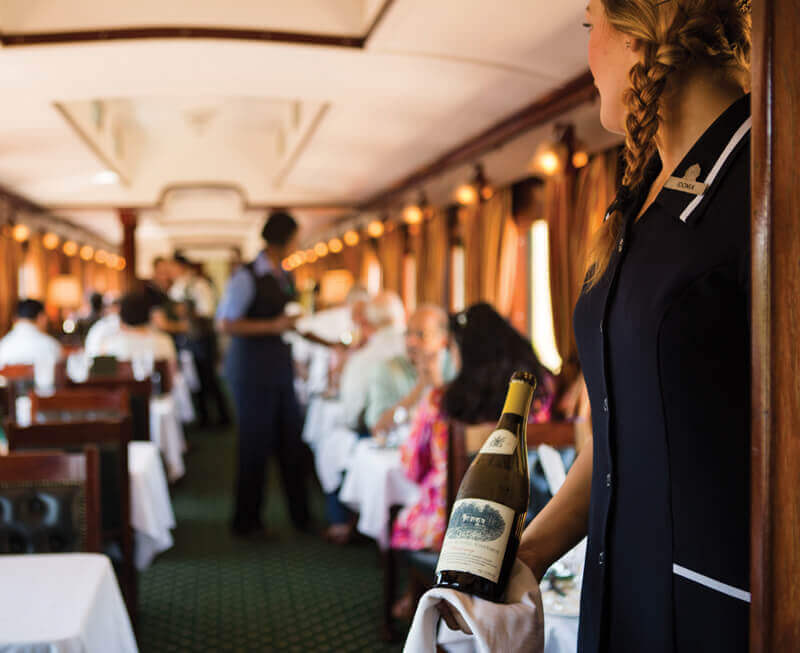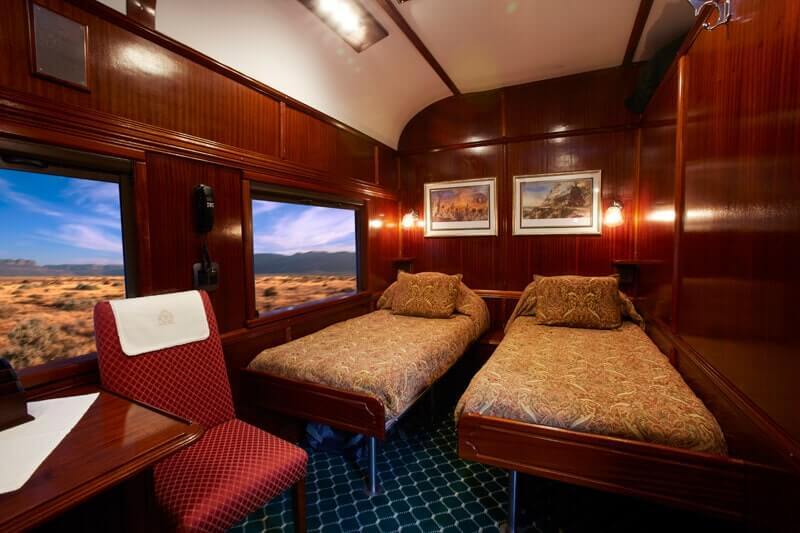The opulent Pride of Africa recreates the golden age of travel
It’s not often that the owner of a railway company comes out to greet passengers as they get ready to board. Indeed, if such a thing happened in the UK they would probably be subjected to a catalogue of gripes about slow running trains, cancellations, over-crowded carriages and more.
 However, one glimpse of the gleaming livery of Pride of Africa, further enhanced by the fact waiters are pouring refills of sparkling wine and serving canapés, gives you a pretty good idea that this is no ordinary train and Rohan Vos is highly unlikely to ever be faced with disgruntled passengers. In fact, we later delight in the fact that occasional delays and a timetable that doesn’t necessarily run like clockwork are among the numerous delights and quirks of Rovos Rail.
However, one glimpse of the gleaming livery of Pride of Africa, further enhanced by the fact waiters are pouring refills of sparkling wine and serving canapés, gives you a pretty good idea that this is no ordinary train and Rohan Vos is highly unlikely to ever be faced with disgruntled passengers. In fact, we later delight in the fact that occasional delays and a timetable that doesn’t necessarily run like clockwork are among the numerous delights and quirks of Rovos Rail.
 We don high vis jackets and follow Rohan around the Pretoria rail yard that lay derelict until the man with big dreams and a passion for rail travel breathed new life into it. His infectious enthusiasm is contagious as he tells us the story of the company that recently celebrated its 30th anniversary. He first came up with the notion of restoring a couple of old railway carriages to take is family on holiday, but quickly found out that hitching privately owned rolling stock to commercial engines wasn’t possible. Undeterred, he started selling a few tickets to get around the red tape. Fast forward to today, and Rovos Rail now employs more than 400 staff, owns one of the largest collections of vintage railway carriages in the world and offers trips in South Africa and beyond.
We don high vis jackets and follow Rohan around the Pretoria rail yard that lay derelict until the man with big dreams and a passion for rail travel breathed new life into it. His infectious enthusiasm is contagious as he tells us the story of the company that recently celebrated its 30th anniversary. He first came up with the notion of restoring a couple of old railway carriages to take is family on holiday, but quickly found out that hitching privately owned rolling stock to commercial engines wasn’t possible. Undeterred, he started selling a few tickets to get around the red tape. Fast forward to today, and Rovos Rail now employs more than 400 staff, owns one of the largest collections of vintage railway carriages in the world and offers trips in South Africa and beyond.
As Pride of Africa pulls out of the station, with Rohan waving from the platform, the personal attention to detail continues on board. Our luggage, collected earlier by smart liveried porters, is waiting for us in our en-suite sleeping carriage where we’re greeted by our personal hostess and members of the Rovos team. On arrival Busi enquires about our favourite drinks and sets about configuring the minibar with our preferred tipples – including proper bottles of spirits, rather than fiddly miniatures – which are replenished as needed. Meanwhile, we are exclaiming over the level of amenities, from a complimentary toiletry bag packed with all kinds of things including lotion, sunscreen, insect repellent and ear plugs. That said, I came to love the soporific clackety-clack of the wheels at night.
 That night, and indeed every night, a gong heralds the evening meal and we make our way to the beautiful dining cars, with their wooden pillars, tasselled curtains, sparkling cutlery and monogrammed plates. Passengers are encouraged to dress for dinner and it feels appropriate in these wonderful surroundings. Many women wear long or cocktail dresses with men resplendent in black tie. The food and wine, South African naturally, is sublime. The scene has the decadent and retro atmosphere of an Agatha Christie novel (minus a murder of course!).
That night, and indeed every night, a gong heralds the evening meal and we make our way to the beautiful dining cars, with their wooden pillars, tasselled curtains, sparkling cutlery and monogrammed plates. Passengers are encouraged to dress for dinner and it feels appropriate in these wonderful surroundings. Many women wear long or cocktail dresses with men resplendent in black tie. The food and wine, South African naturally, is sublime. The scene has the decadent and retro atmosphere of an Agatha Christie novel (minus a murder of course!).
By day the focus is on sights outside the windows as our journey takes us ever onwards to Cape Town, passing rural villages where waving children line the track, sweeping plains with grazing wildebeest, rugged purple mountains, lush wetlands filled with flamingos and verdant wine estates. Sunsets are particular spectacular and most of us gather in the observation car at the back of the train, also conveniently housing the bar, and before heading to the outdoor viewing carriage to watch the blood red sun dip over the ever-changing horizon.
 Each day brings an excursion. We disembark at Kimberley, the capital of the Northern Cape Province. It was here the first South African diamond was discovered by accident in 1867 when a young led picked up a surprisingly shiny ‘pebble’ beside a river. This led to the frenzied rush and the world’s largest diamond mine, the cavernous 700ft pit known as Big Hole. Dug entirely by men, it yielded some of the world’s biggest diamonds which made the De Beers name famous around the world. Today you can gaze into the mine and walk around a reconstruction of Kimberley’s 19th century mining settlement where original buildings, including a church, shops and homes, have been relocated. Afterwards we enter a guarded vault filled with more than 35,000 glittering stones.
Each day brings an excursion. We disembark at Kimberley, the capital of the Northern Cape Province. It was here the first South African diamond was discovered by accident in 1867 when a young led picked up a surprisingly shiny ‘pebble’ beside a river. This led to the frenzied rush and the world’s largest diamond mine, the cavernous 700ft pit known as Big Hole. Dug entirely by men, it yielded some of the world’s biggest diamonds which made the De Beers name famous around the world. Today you can gaze into the mine and walk around a reconstruction of Kimberley’s 19th century mining settlement where original buildings, including a church, shops and homes, have been relocated. Afterwards we enter a guarded vault filled with more than 35,000 glittering stones.
 Next morning we alight at the charming town of Matjiesfontein, with its museum of old cars and railway carriages and quaint shops. As always, we are welcomed back aboard with cold towels and a glass of fizz before the Pride of Africa rolls on through the dramatically changing landscape; occasionally stopping due to a hold-up ahead. There is really no need for the train manager to apologise, even though he does. Passengers simply carry on reading and chatting in the lounge car, order another cocktail in the bar or, depending on the time of day, enjoy afternoon tea. Meanwhile, smokers can retire to the fug of the smoking car.
Next morning we alight at the charming town of Matjiesfontein, with its museum of old cars and railway carriages and quaint shops. As always, we are welcomed back aboard with cold towels and a glass of fizz before the Pride of Africa rolls on through the dramatically changing landscape; occasionally stopping due to a hold-up ahead. There is really no need for the train manager to apologise, even though he does. Passengers simply carry on reading and chatting in the lounge car, order another cocktail in the bar or, depending on the time of day, enjoy afternoon tea. Meanwhile, smokers can retire to the fug of the smoking car.
At night we return to our sleeping compartment to find the toasty beds warmed by electric blankets and topped by the biggest cloud-like duvets I’ve ever seen. On the table is a kettle with freshly boiled water for tea or coffee, biscuits and other treats.
 Although smoking is allowed in the well sectioned off area, the main irritant of modern-day train travel – the omnipresent mobile phone and being an enforced eavesdropper to loud and often tedious exchanges – is not. And what a refreshing change it is. Convivial conversations flow and friendships are formed as the Pride of Africa continues its stately journey at an average speed of 37mph. That said, as I gaze out of the window at wildebeest, take another sip of distinctive Six Dogs gin which wondrously turns from blue to pink when the tonic is poured, it would be very tempting to call someone and say “I’m on the train”. This really is a journey worth talking about.
Although smoking is allowed in the well sectioned off area, the main irritant of modern-day train travel – the omnipresent mobile phone and being an enforced eavesdropper to loud and often tedious exchanges – is not. And what a refreshing change it is. Convivial conversations flow and friendships are formed as the Pride of Africa continues its stately journey at an average speed of 37mph. That said, as I gaze out of the window at wildebeest, take another sip of distinctive Six Dogs gin which wondrously turns from blue to pink when the tonic is poured, it would be very tempting to call someone and say “I’m on the train”. This really is a journey worth talking about.
More information
Silver Travel Advisor recommends Great Rail Journeys.












2 Responses
I took the train from Livingston to Victoria Falls. Expensive? Of course, it is, but well worth it for a “bucket-list” experience. Contact their website Rovos Rail for details.
I could only dream of this fabulous train journey,